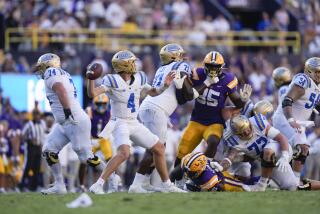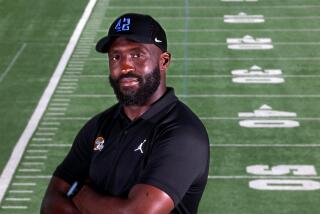Smith Finds a Home With Bruins
It’s been a climb, then a fall and another climb for Damon Smith, who is used to going uphill because he has spent a football lifetime being told he’s not good enough.
And has spent two seasons as a defensive tackle at UCLA proving the naysayers wrong. His 24 tackles a year ago offered support for his claim, and he has 13 this season--three for losses--as the Bruins’ most productive defensive lineman.
Smith’s road to Westwood was a long, circuitous one, and his personal streets there have been fraught with potholes.
Earl Bruce had wanted him at Colorado State. Smith had grown up in Beachwood, a suburb of Cleveland, and Bruce had Ohio connections from his days as Ohio State’s coach. Smith was all set to go to Fort Collins, but then Colorado State didn’t want Earl Bruce as its coach and certainly didn’t want Smith.
Northwestern called, but then didn’t take a return call.
Youngstown State was around, and then wasn’t around.
Ashland University, a Division II school in Ohio, about 60 miles from Cleveland, wanted Smith. But he found out after two years, and one season in which he had 53 tackles and six sacks, that he didn’t want Ashland.
He was like every other Division II or III player who has watched a major college game on television and said, “That should be me. There’s no reason that isn’t me.”
They are dreamers, and most are wrong.
“At UCLA,” says Barbara Hancock, Smith’s mother, “Ed Kezirian allowed him to dream.”
Kezirian is a former UCLA offensive line coach who now works with the program in a variety of ways, largely as an academic liaison. Smith showed up in Kezirian’s office one day, seeking transfer information.
“He had come in during the spring break of his first year at Ashland,” says Kezirian. “He wasn’t all that big really. Then he came back the next year, and he had gotten a lot bigger. He gave us some film, and I turned it over to Bob Field [then the defensive coordinator].”
Smith had grown from 6 feet 1 and 230 pounds to 6-3, 270, and Field liked what he saw. But UCLA couldn’t talk with Smith while he was at Ashland. That wasn’t going to be much longer.
“My position coach, [John] Saccomen, had told me he thought I could do it, but the head coach [Gary Keller] said, ‘You can’t even make the team there,’ ” Smith says. “He yelled at me and gave me a hard time about getting my release.”
When it was given, Hancock, a psychotherapist living in Bel Air, flew her son to Los Angeles where the Bruin coaching staff said he could walk on. Big deal.
“We didn’t have to invest much in him,” Kezirian said.
UCLA has been amply rewarded. After a year as a walk-on, playing on the scout team, Smith was given a scholarship by Coach Bob Toledo.
“We had some scholarships available, and he had played well with the scouts,” says Toledo. “I wanted to show walk-ons they could . . . earn a scholarship.”
Smith was made an example, and showed he belonged.
“When I came in, guys like Grady Stretz and George Kase and Travis Kirschke were here, and they were better athletes than I was,” Smith says. “But I felt like I could compete.
“I was sitting out, so in two-a-days [before the season], every practice was a game for me.”
The role of the scout team is being beaten up by the starters. It’s a learning process in which the scouts become this week’s opponent, running plays or defensive formations to allow the varsity to prepare for a game.
“I was up against Matt Flanagan, who was All-Pac-10, and James Christensen and [Outland Award winner] Jonathan Ogden, and I didn’t get beaten on,” Smith says. “I was playing.”
And then Smith was a scholarship player, preparing for his first game, against Tennessee.
It was an emotional time, with his father, a high school principal in the Joe Clark tough-love mold, driving down to Knoxville. He had advised his son to stay at Ashland, and here he was, in front of 106,297 people in Knoxville.
“He had walked all the way around the stadium while I was warming up,” says Smith. “He’s a big guy, always wears a gray suit, and they call him ‘Robocop’ at school. He’s a strong disciplinarian.
“And there he was, standing in the front row, closest to where I was warming up, there with my little nephew, and he was yelling at me. And he said, ‘I’m proud of you.’ It’s the only time he’s ever said that to me.”
Warmups finished, Smith sought out Kezirian.
“He came up to me, hugged me and said, ‘Thank you for making this happen,’ ” Kezirian says.
And then, Tennessee provided a revelation.
“I’ve never seen anything so fast,” Smith says. “Not in Division II, not anywhere. It took me a half to get up to speed.”
He started the game and finished with six tackles. Smith split starting assignments with Darren Cline until UCLA’s coaches moved Weldon Forde from nose tackle to defensive end.
Smith wasn’t a defensive end, though.
“I’m not a particularly good pass rusher,” he says. “I’m better in traffic.”
Stretz, now a graduate assistant, agrees.
“He’s a leverage player, getting low and using his strength,” he says. “Damon’s a very strong player.”
He had a strong senior season to look forward to, until an incident during the winter. Smith and a walk-on player had nursed a personality conflict through much of the season, and it flared during an intramural basketball game when Smith punched the other man, who is no longer with the UCLA program.
“He had to apologize to the player,” Toledo says. “With 107 people on a team, they’re not always going to get along, but we couldn’t have that.”
Whose fault it was, nobody will say, but Smith spent his mornings during spring practice running punishment laps. And his afternoons practicing poorly.
His summer was spent working alone, staying away from players with whom he had a conflict.
“He worked it out for himself,” Hancock says. “I’d ask him a question, but he said, ‘Mom, I can handle it.’ What’s really important to him is that he is respected for his ability.”
He came into preseason practice on the outside, looking in for playing time.
It was not punishment, Toledo insists.
“I only play people based on performance,” he says.
Injuries cropped up with others, and Smith had two tackles at Washington State. Then three against Tennessee and six at Texas, two of them for losses. Four tackles and a fumble recovery against Arizona, and the doghouse apparently is behind him. A defensive award for this week, given by UCLA’s coaches, was an indicator.
The road from Ohio was at an end, the top has been reached, the valley has been crossed and Smith was in Division I.
Where he belonged.
More to Read
Go beyond the scoreboard
Get the latest on L.A.'s teams in the daily Sports Report newsletter.
You may occasionally receive promotional content from the Los Angeles Times.






